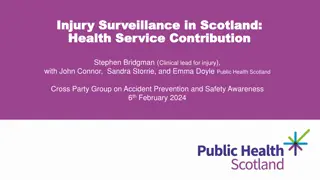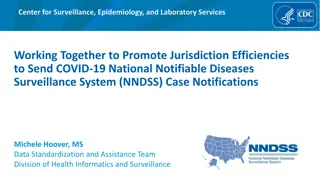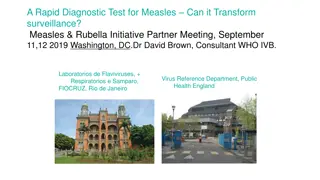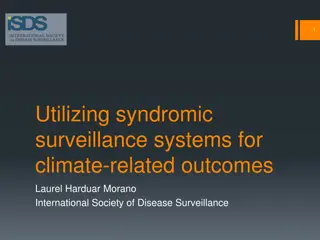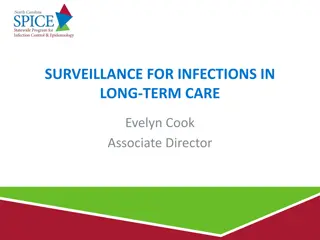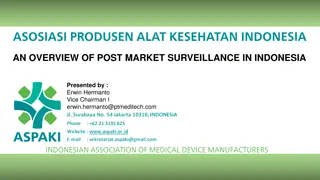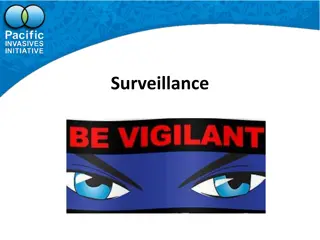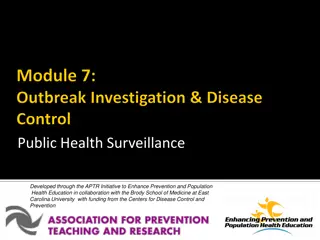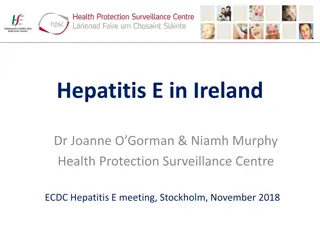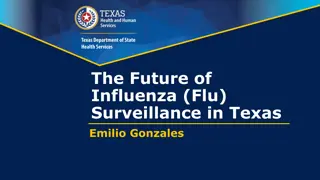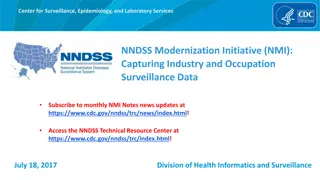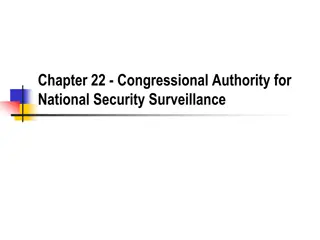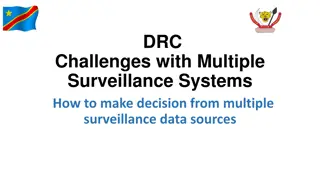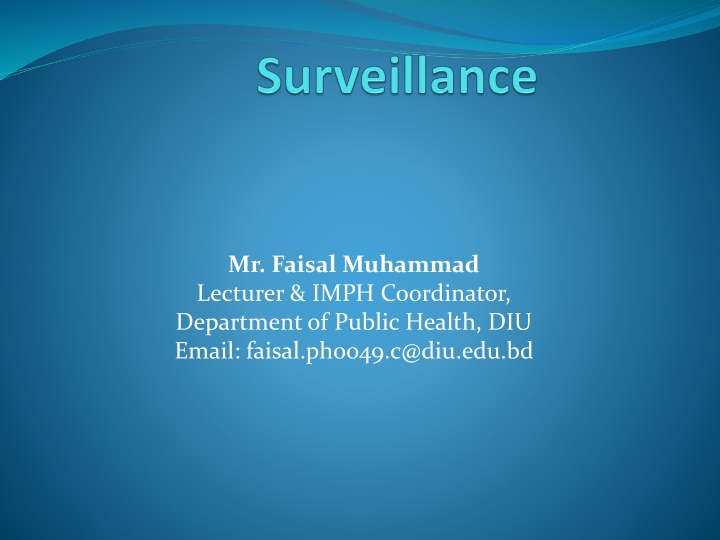
Understanding the Importance of Epidemiological Surveillance in Public Health
Learn about the significance of epidemiological surveillance in public health, including its objectives, main purpose, and functional elements. Discover common methods used for data collection and explore examples of surveillance objectives in diseases like tuberculosis, dysentery, ARI, and AIDS.
Download Presentation

Please find below an Image/Link to download the presentation.
The content on the website is provided AS IS for your information and personal use only. It may not be sold, licensed, or shared on other websites without obtaining consent from the author. If you encounter any issues during the download, it is possible that the publisher has removed the file from their server.
You are allowed to download the files provided on this website for personal or commercial use, subject to the condition that they are used lawfully. All files are the property of their respective owners.
The content on the website is provided AS IS for your information and personal use only. It may not be sold, licensed, or shared on other websites without obtaining consent from the author.
E N D
Presentation Transcript
Mr. Faisal Muhammad Lecturer & IMPH Coordinator, Department of Public Health, DIU Email: faisal.ph0049.c@diu.edu.bd
Surveillance Surveillance is an ongoing systematic collection, collation, analysis and interpretation of data and the dissemination of this information to those who need to know in order that action may be taken.
Epidemiological surveillance It is the epidemiological study of disease as a dynamic process involving the ecology of the infectious agent, the host, the reservoirs and the vectors , as well as the complex mechanism concerned in the spread of infection and the extent to which this spread occurs.
Objectives of surveillance Epidemic or out break detection Monitoring trend of endemic disease Evaluating an intervention Monitor progress towards a control objective Monitor programme performance Epidemic detection Estimate future disease impact
Main purpose of surveillance is to detect changes in disease trend and distribution to initiative investigative or control measures. Surveillance can assume many character and dimension- Epidemiological surveillance Demographic surveillance Nutritional surveillance Serological surveillance
Example of surveillance objectives Tuberculosis- To monitor the ability of the TB programs to detect cases, ensure treatment completion and cure. Dysentery- To detect outbreaks of Dysentry by monitoring the incidence of cases of acute bloody Diarrhoea . ARI- To monitor the incidence and case fatality rate of ARI in children under 5 AIDS To measure the incidence of AIDS cases so that future trends may be predicted and health services planned.
Functional Elements Surveillance has four functional elements: Data collection Data compilation and analysis Action taken on reports Feed-back.
Methods commonly used for data collection Routine reporting of cases I) Passive for institute based reporting ii) Active surveillance Sentinel surveillance Disease surveys Epidemiological investigations Laboratory surveillance
Active surveillance Regular periodic collection of case reports from health providers or facilities is done through a format. This is done by actively looking or searching for particular type or group of disease those were unreported. The disease of reports is more complete and accurate, e.g. AFP surveillance in Bangladesh
Passive surveillance Simplest and most widely practiced way of collecting information on cases and deaths. The health service providers give reports of cases at their discretion. Though this is an inexpensive type of surveillance but the data are likely to understand the presence of disease in the population.
Sentinel surveillance This type of surveillance is done where a sentinel center ( a hospital , health centre or laboratory where a large no. of patients attend) is placed to keep watchfulness eyes for any unseemly health hazard. This is developed to obtain more reliable and extensive disease information than is available from the routine reporting centers. This case report indicated a failure of the health care system as well as any special problem to emerge.
Compilation and analysis of data It is necessary to maintain charts and graphs which show the number of cases of the disease for each reporting period. A map is commonly used to monitor the location of diseases during investigation. After compilation of data for the most recent reporting period, it needs to be analyzed according to time, place and person.
Action taken on reports Action has to be taken to correct any problem uncovered during the analysis. If increased rate of morbidity or mortality are documented , health authorities have the responsibilities to control the situation. Purpose of analysis is thus not only to determine what happened but also decides if any action to be taken.
Feedback To ensure the reporting until at the various levels remain motivated and involved in the surveillance process, there must be regular communication back from higher levels of programme management to lower levels. This can be done through communication in staff meeting s, preparation of the brief summary reports and publication of new letters. The feedback should include comments on the performance recording and reporting of cases and suggestions on solving problems in collection of data. The feedback will keep the stuff motivated by helping them to understand the information they collect is important.
Rationale for disease surveillance Public health importance of disease ? Can public health action be taken ? Are relevant data easily available? Is it worth the effort(money, human and resources)?
Disease under international surveillance At the international level , the WHO maintain surveillance of important disease of public health importance : Influenza, salmonellosis, paralytic polio, malaria, epidemic typhus, relapsing fever, hemorrhagic fever, rabies, dengue, neonatal tetanus, plague ,cholera, measles, AIDS. It makes this information available through its publication : WHO weekly Epidemiological Record, WHO Epidemiological reports(monthly) and vital statistics
Surveillance : basic ingredients A good network of motivated people Clear case definition and reporting mechanism Efficient communication system Basic but sound epidemiology Laboratory support Good feedback and rapid response Preparation for proforma and format to be used Selection of cases to be taken.
Rationale for disease surveillance Public health importance of the disease? Can public health action be taken? Are relevant data easily available? Is it worth the effort?(Money, human and resource)
Standard case definition The classification of cases may be given broadly as follows: Suspected case- diagnosis made on clinical ground by health workers. Probable case- diagnosis made on clinical grounds by medical officer. Confirmed case- Clinical diagnosis by a medical officer and / or positive laboratory identification of the disease.
Reporting mechanism Regularity of reports- this should be ensured. For this a list of reporting units within the jurisdiction of the health facilities is must. Make sure that all units send the reports in time and the reports are complete. Even if there is no case of the disease under surveillance , a NILL report is a must. System of recording and reporting : Peripheral units record the details of cases in respect to their name , age, sex, address, date of one set of symptoms , diagnosis and outcome of the disease with data. Simple standardized forms of recording and reporting cases help to improve the surveillance system.
Support activities for surveillance Setting standards Training Supervision Community system resources
Surveillance : Indicators(SMART) Specific Measurable Action oriented Realistic/Reliable Timely
Key activities for improving surveillance 1. Review the routine reporting system 2. Establish a network of sentinel reporting sites. Strengthen the organizational capability for investigation , when needed and control of outbreak.


